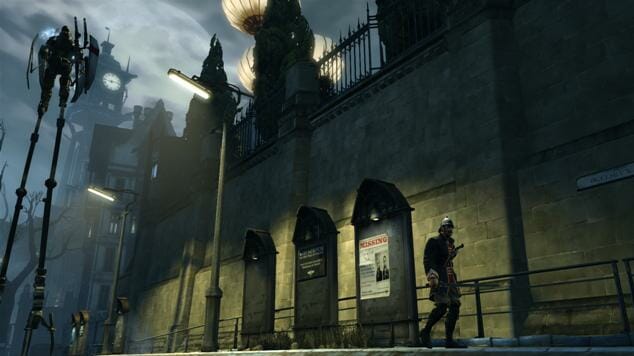Dishonored (Multi-Platform)

“Revenge solves everything,” goes the tagline of Arkane Studios’ Dishonored, but the game isn’t really about vengeance. On a superficial level, it makes sense. Your character, a skilled bodyguard turned assassin named Corvo Attano, is framed for the murder of the beloved Empress and the kidnapping of her daughter Emily. Breaking out of prison six months later, Corvo joins up with a loyalist group working in secret to overthrow the corrupt regime that’s taken over the plague-infested city of Dunwall. It’s natural he’d want some payback.
But as the story of this first-person stealth game develops, you sense that revenge might not be the dominant theme. Instead, Dishonored is about loyalty: loyalty to country, to honor, to friends. In inhabiting Corvo’s many roles—as Emily’s Lord Protector, as revolutionary, as assassin—the player is encouraged to explore that theme from a variety of angles, both by shaping the plot through his actions and by reacting to its multiple twists.
If all that sounds a bit heady for a game where you stab dozens of dudes in the neck, well, it is. But the genius of Dishonored is how subtly its fiction and mechanics work together to draw the player into its world.
Despite its squalor, Dishonored’s world is a fun one to inhabit. Dunwall, like Rapture in BioShock, is a ruined city built on the fortunes of a magical substance (in this case, whale oil instead of ADAM). Like BioShock, Dishonored also contains some fascinating environmental storytelling via the placement of objects, bodies, audiograph logs and books. “Steampunk” is probably the best word to describe the setting, but Dishonored avoids falling into the trap of many works in this genre by not overloading the player with fantasy technology and mythology. Both are present, allowing for the use of nifty gadgets and magical powers. But throughout the well-paced (and surprisingly coherent) plot, the game’s writers consistently keep the focus on character, lending the experience the universality needed to resonate with players of all kinds.
To say much more about the story and character development would spoil the joy of discovery. But Arkane’s approach to narrative design does include at least one interesting experiment. Your decisions shape the story, which is nothing new. But what’s neat is how that operates on a micro level, too: it’s not just conversation-wheel choices or “Press A to spare this person” moments that influence future levels, but also how many enemies you kill rather than knock out or avoid. The game doesn’t make explicit exactly how your “Chaos” rating, viewed at the end of each mission, works. But keeping it low by avoiding killing does ultimately lead to a happier ending. More interestingly, it also determines how many enemies will be in the next level. Kill a lot of guys, and you’ll have to face more of them in the next level.

Dishonored bills itself as built for players who like killing enemies and those who don’t, and it succeeds remarkably well on both fronts. The variety of weapons and powers allows for both styles of play, and it’s satisfying to pursue either course, or both. But what endeared me most to the game is the subtle ways it rewards you for not killing. Throughout the campaign, you’ll be tasked with assassinating key targets to take down the evil empire. Yet for each, exploring the level fully—either physically, by seeking alternatives within the space itself, or through conversation with NPCs—presents a nonlethal alternative. In most cases, other characters will reward you with supplies or cash for choosing this path, but just as rewarding are the alternative story branches nonlethal solutions create. In fact, I felt more like a badass when I didn’t kill enemies, when I snuck past them or knocked them out silently. Of course, blasting dudes with explosive bullets or summoning a piranha-like swarm of rats to devour them alive feels great too.
-

-

-

-

-

-

-

-

-

-

-

-

-

-

-

-

-

-

-

-

-

-

-

-

-

-

-

-

-

-

-

-

-

-

-

-

-

-

-

-








































